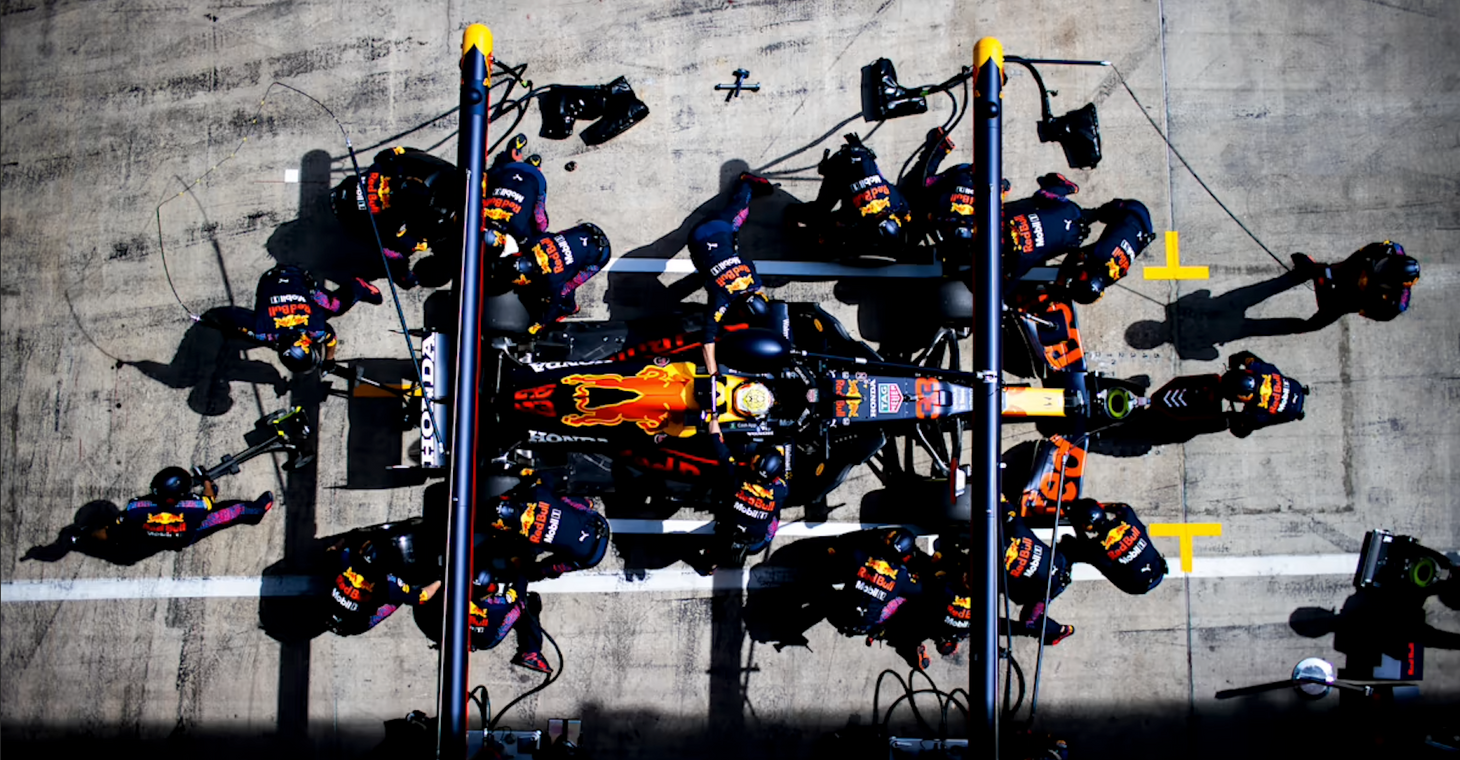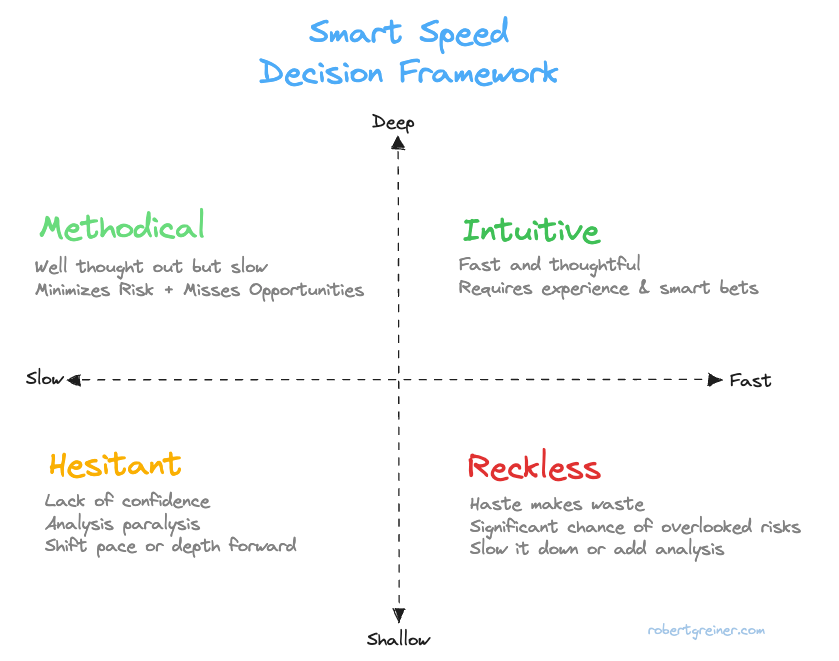Move Fast and Don't Break Things
The art of smart speed in organizational decision-making.

In 2013, Lululemon was enjoying remarkable success. Their finely crafted see-through yoga pants were selling at an astonishing rate. High on sales reports, founder and then-CEO Chip Wilson decided to aggressively expand - promising to double Lululemon's 200+ stores within two years. The growth dial was turned up to 11.
But the rapid expansion took its toll. Customers searching for the next fashion trend faced empty shelves and shoddy products that didn’t match Lululemon’s signature quality. The company struggled to keep up. Shortages plagued the supply chain. Production slowed to a crawl. Severe quality control issues slipped through the cracks. If that wasn’t bad enough, the hastily hired and unmistakably untrained staff lacked the expertise and trademark friendless customers expected, ruining the in-store experience Lululemon worked so hard to cultivate over the years.
Ultimately, Lululemon moved too fast and broke everything along the way. Hasty decisions pursuing breakneck growth backfired spectacularly, damaging the brand, culture, and supply chain as leadership blindly chased speed over sustainable, managed growth. The result? In a short 14-month period, Lululemon lost two CEOs and over $100M in value before slowly starting to recover in 2014.
The Power and Perils of Speed
"Move fast and break things. Unless you are breaking stuff, you are not moving fast enough." -Mark Zuckerberg
Speed matters. Moving quickly allows you to gain ground and build momentum before competitors can react. Speed builds conviction and momentum. As decisions compound, they cultivate organizational intuition and pattern recognition. Employees want to work for an inspiring organization doing meaningful things with pace and purpose.
But uncontrolled speed is perilous. Decisions made in haste, without proper diligence and validation compromise quality, culture, and brand. Organizations lured by the temptation of unbridled velocity in growth, sales, time-to-market, etc. are like Icarus, hurtling ever closer to the sun.
What can we learn from Lululemon's mistakes? How can organizations move quickly and nimbly, taking the company to new heights, without succumbing to the siren call of reckless, uncontrolled decision-making?
Harnessing the Power of Smart Speed

The key is finding the right balance - combining velocity with good judgment - harnessing swiftness while maintaining thoughtful deliberation. Like a chef who has cooked her signature dish 10,000 times. She no longer relies on an exact recipe, but can adapt to the situation and lean on her years of experience to make the best Mushroom Risotto you’ve ever tasted even though the original recipe called for butternut squash.
In practice, balancing speed and judgment is easier said than done. Organizations typically oscillate between reckless speed and excessive caution creating a whiplash effect. How can leaders practically shift toward smart speed - gaining the benefits of pace but reaping the rewards of thoughtfulness?
There is a way to navigate this treacherous crossroad. Some situations demand quick decisions, and the appetite for less rigor is higher - crisis management, seizing a fleeting opportunity, or changing direction after learning something new. Others necessitate slower, deeply analyzed choices to successfully navigate a complex environment with a lower margin for error - digital transformation, entering new markets, or developing a new compensation plan. Exceptional decision-making requires leaders to understand what the situation requires and whether or not more pace or deeper analysis is needed to succeed.

Smart Speed Done Right
Organizations have practically and successfully implemented the principles of smart speed to take their company to the next level. Let’s look at a few examples:
Red Bull F1 - challenging the status quo.
The highest-performing teams on the planet move with a sense of pace and purpose. The Red Bull Formula 1 team has won an awe-inspiring six championships. They push the envelope weekly with their driving tactics, engineering, and teamwork to maximize performance. You are safer going 220mph in an F1 car than driving 65mph down the Pacific Coast Highway. F1 embodies smart speed.
The entire Red Bull team is laser-focused on one objective: winning the next championship. Their hive-mentality has no room for the status quo, and the team is not bound to the “racing traditions” of some of the more established teams like Ferrari, Alpine/Renault, and McLaren. This allows Red Bull to push the envelope quicker than their competitors and has made Christian Horner the most hated Team Principal in all of F1.
Amazon - small and nimble teams.
Amazon is renowned for its Day One mentality and relentless pursuit of speed. But generally, they have found success balancing quick decision-making with exceptional judgment. Their famous two-pizza teams are small, nimble, and empowered to move fast and make key decisions. They experiment, fail, iterate, adjust, and move forward - spurred by leadership’s overcommunication around the importance of customer obsession.
Microsoft - the best at being second.
Throughout its history, Microsoft has excelled at being the “fast follower” - letting other companies blaze the trail with new product categories and jumping in once it’s clear there is a viable market. Microsoft was late to the browser wars with Internet Explorer and jumped on the public cloud hyperwave after AWS started gaining traction. Microsoft’s foray into generative AI is following a similar path. Microsoft knows that moving first has advantages, but being second allows you to perfect and amplify innovations with far less risk. In Microsoft’s case, being late to the party can be a strategic and wise move.
Threading the Needle: The Art of Smart Speed
Lululemon’s past provides a cautionary reminder of the perils of unchecked speed. But speed is critical to maintain an advantage. To build a high-performance organization, we must thread the needle between two extremes: on the one hand, chaotic speed without safeguards will lead to costly missteps. On the other hand, an overabundance of caution leads to analysis paralysis, stalling progress and innovation. Building a high-performance organization requires a balancing act between these two polar extremes.
The gold standard is smart speed - harnessing velocity while maintaining thoughtfulness and control. With the right communication, talent, systems, and culture, organizations can operate with startup-level hunger and speed while maintaining the ability to scale.
As a leader, take stock of your organization's speed. Are decisions made thoughtfully and quickly? Are teams empowered to act? Is communication frequent and transparent? Do you have the systems and culture to enable rapid iteration and learning?
The era of "move fast and break things" is over. Welcome to the age of "move smart and break barriers." Start today by initiating a 'Smart Speed Audit' within your organization. Identify bottlenecks and areas of recklessness and put corrective measures in place. Harness speed as your strategic ally today, or risk it becoming tomorrow's liability.
How did you like this article? Your feedback helps me create better content.
Thanks for reading.
Subscribe for Free
Want to stay ahead of the curve? Subscribe now to receive the latest updates, actionable insights, and thought-provoking ideas around business, technology, and leadership straight to your inbox.



